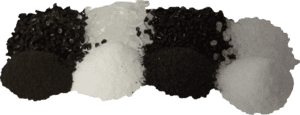Fluoropolymer Resins
Tef Cap Industries processes Fluoropolymer products that exhibit excellent electrical , physical and chemical properties. Most Fluoropolymer resins are going to be almost 100 % chemically inert with exceptions to solutions of molten alkali metals, liquid or gaseous fluorine and some chemicals that lubricate fluorine gases at elevated temperatures.
The main feature of Fluoropolymer’s are their ability to withstand elevated temperatures while remaining virtually chemically inert in any environment. Fluoropolymers have a very low coefficient of friction which is the reason for their anti-stick properties, they are also highly resistant to UV light and are an excellent electrical insulator.
Our products are available in fluoropolymer resins such as :

Fluoropolymer Resins and Material
Ethylene Chlorotrifluoroethylene
ECTFE (or Halar) is a melt processable Fluoropolymer resin consisting of ethylene (E) and chlorotrifluoroethylene (CTFE) polymers. ECTFE is suitable for use as a coating material in protection and anti-corrosion applications in the automotive and aerospce industry.
Working Temperature : 302°F ( 150°C )
Perfect substitute for Rigid PFA pipe
- High Impact Resistance
- Excellent chemical resistance
- High Flame Retardancy
- Resistant to Mineral and Oxidized Acids
Ethylene Tetrafluoroethylene
Ethylene tetrafluoroethylene (ETFE) is a fluorine-based plastic. It is designed to have excellent mechanical strength, rigidity and abrasion resistance. ETFE is highly resistant to stress cracking and is an ideal covering for wires and wire harnesses in the Aero-Space and Fiber Optics industry.
ETFE’s stiffness and abrasion resistance properties protect mixers and paddles in abrasive slurries and baths that often quickly deteriorate other coating and sprays.
Working Temperature : 302°F ( 150°C )
Color : Transparent and clear
- Increased mechanical strength
- Excellent chemical resistance
- Long continuous lengths
- Radiation resistant
Fluorinated Ethylene Propylene
Fluorinated Ethylene Propylene or FEP is a type of Fluoropolymer Resin manufactured from a copolymer of hexafluoropropylene and tetrafluoroethylene. It differs from the PTFE resins in that it is manufactured using a melt-process technique. FEP is very similar in composition to the fluoropolymers PTFE and PFA. FEP & PFA share some of the same properties as PTFE like low friction and non-reactivity, but are more easily formable. FEP is softer than PTFE and melts at 260 °C; it is highly transparent and resistant to sunlight and UV rays.
FEP resins are very transparent and can withstand exterior elements making them extremely beneficial for site gauges in fluid transfer applications. Products produced with FEP resins also meet all FDA requirements for repeated contact with food, their non-stick properties allow transport of sticky material without line clog or reducing flow rates.
Working Temperature : 400°F ( 205°C )
Color : Clear
- Excellent chemical resistance
- Non wetting
- Weldable
- Tubes can be sealed
- Long continuous lengths
- Low refractive index
- Improved clarity over PFA
- Lower cost alternative to PFA
Polyetherether Keton
Poly ether ether ketone (PEEK) has attractive properties like good abrasion resistance, low flammability and emission of smoke and toxic gases, resistance to radiation and high temperature steam, and low water absorption. PEEK is an aromatic polyether, high-performance colorless organic thermoplastic polymer in the Polyaryletherketone (PAEK) family. PEEK resins and tubing are used in the insulation of wire and cables and highly sought after in machine and engineering applications
Working Temperature : 392°F ( 200°C )
Color : Light tan , amber
- Excellent chemical resistance
- Excellent steam resistance
- Excellent strength to weight atio
- Outstanding wear resistance
- Excellent outgassing characteristics
- Self-extinguishing
- Excellent tensile strength
Perfluoroalkoxy Alkane
Perfluoroalkoxy Alkanes or PFA is a type of fluoropolymer. In terms of its properties, PFA polymers are similar to polytetrafluoroethylene (PTFE). The big difference is that the alkoxy substituents allow the polymer to be melt-processed with very high purity. The physical and chemical makeup of PFA results in a material that is more translucent and has improved flow, creep resistance, and thermal stability close to that of PTFE. PFA resins have a very low absorption rate.
Working Temperature : 500°F ( 260°C )
Color : Clear with light blue tint
- High purity resins available
- low permeation resins available
- Working temperature of PTFE but optical clarity of FEP
- Exceptional heat resistance
- self-extinguishing
- non wetting
- good flex life
- laser markable
Polytetrafluoroethylene
Polytetrafluoroethylene (PTFE) is a synthetic fluoropolymer of tetrafluoroethylene that has numerous applications. PTFE is a solid fluorocarbon, as it is a high-molecular-weight compound consisting wholly of carbon and fluorine. PTFE is a hydrophobic material: neither water nor water-containing substances wet PTFE. Polytetrafluoroethylene has one of the lowest coefficients of friction of any solid. PTFE is the most widely used and most common Fluoropolymer resin available. PTFE is also virtually unaffected by UV light, ozone or by oxygen. The mechanical properties of PTFE can be greatly improved by adding fillers such as carbon, glass or graphite making it comprable to other engineered plastics.
Working Temperature : 500°F ( 260°C )
Color : Opaque to Translucent, light blue tint
- Chemically inert
- Lowest coefficient of friction
- Superior dielectric strength
- Exceptional heat resistance
- Self-extinguishing
- Non wetting
- Excellent flex life
- Laser markable
Polyvinylidene Fluoride
Polyvinylidene Fluoride, or polyvinylidene difluoride (PVDF) is a highly non-reactive and pure thermoplastic fluoropolymer produced by the polymerization of vinylidene difluoride. Often refered to by the trade name Kynar.
PVDF is a specialty plastic material in the fluoropolymer family; it is used generally in applications requiring the highest purity, strength, and resistance to solvents, acids, bases and heat and low smoke generation during a fire event. Compared to other fluoropolymers, it has an easier melt process because of its relatively low melting point of around 177 °C.
Working Temperature : 265°F ( 130°C )
Color : Natural, slight brown tint
- Very good chemical resistance
- Excellent resistance to fatigue and creep
- UV resistant
- Weldable
- Corrosion resistant to chlorine, fluorine and bromine
Tetrafluoroethylene Hexafluoropropylene Vinylidene
When combined together these three copolymers tetrafluoroethylene, hexafluoropropylene and vinylidene produce an extremely flexible fluoropolymer simply called THV. THV offers high resistance to chemicals, is highly flexible and offers excellent transparency. Tubes manufactured from THV resins feature exceptional optical clarity and allow for UV pass through.
THV tubing and products have a slight tacky characteristic that allows it to easily be bonded to plastics and other elastomers.
Working Temperature : 248°F ( 120°C )
Color : Transparent
- Permits bond ability to other substrates without surface treatment
- Wettable
- Excellent optical clarity
- Low refractive index
- Excellent chemical resistance
- Unmatched flexibility
- Excellent permeation resistance
Some of these resins are normally associated with trade names and trademarks such as
Teflon®, Kynar®, Tefzel®, Solef®, Halar®, Hylar®, Aflon®, Victrex®, Neoflon® and Hyflon®
